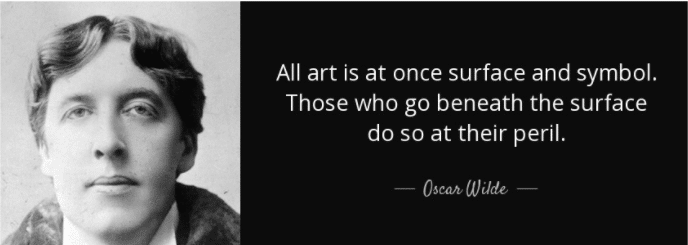
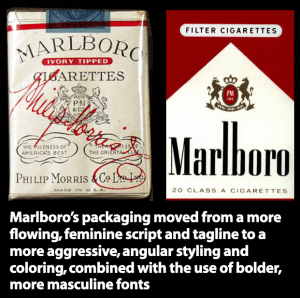 Marlboro cigarettes had a marketing challenge.
Marlboro cigarettes had a marketing challenge.
From 1924 to the early 50s, Marlboro was a failed filtered cigarette brand, marketed to women with the slogan “Mild as May”
As you can imagine, men were loath to be seen smoking a woman’s cigarette — even if they may have preferred a filter!
So Marlboro called in advertising genius Leo Burnett, with the aims of relaunching the product as a mainstream man’s cigarette.
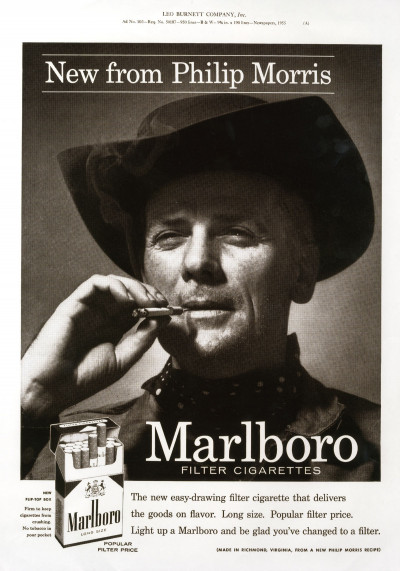
Their aim was not only to reboot the brand but to make filtered cigarettes socially acceptable for men.
Part of the solution was to re-package the product in a way that evoked masculinity.
Hence the distinctive Marlboro packaging, complete with a red chevron designed to look like a military medal.
But the advertising solution was even simpler.
The Burnett Agency used the ads to associate Marlboro with virile masculinity.
How?
By showing masculine, virile men using and endorsing the product.
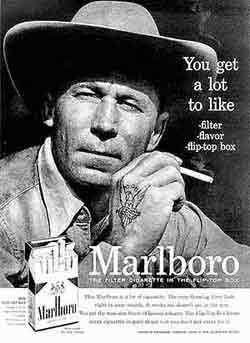
And that, dear reader, is how the Marlboro Man was born.
Thanks to that manly man cowboy, Marlboro sales exploded, moving from also-ran to 4th most popular in a matter of months. Within years, Marlboro became the most popular cigarette brand in the US.
In 1955, when the Marlboro Man campaign was started, sales were at $5 billion. By 1957, sales were at $20 billion, representing a 300% increase within two years.
But just because this tactic worked back in the relatively unsophisticated advertising landscape of the 50s doesn’t mean it still works now, does it?
Same Challenge, Same Strategy
Yes, actually, it does.
Take the example of Lite Beer from Miller.
Believe it or not, prior to the mid 1970s, Miller’s flagship product wasn’t Miller Lite — it was Miller High Life.
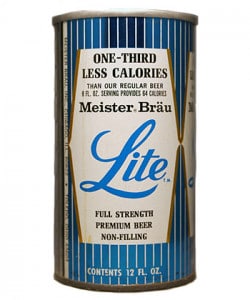 But when Miller acquired Meister Brau, they also acquired the rights to a then unique product: Meister Brau Lite.
But when Miller acquired Meister Brau, they also acquired the rights to a then unique product: Meister Brau Lite.
It was the only lite beer in existence, with a special brewing process, and an avid following among steelworkers in Anderson, Indiana.
They liked it because they liked the taste — but also because they didn’t realize it was a light beer.
Miller’s plan was to re-package Meister Brau Lite as “Lite Beer from Miller” (and eventually as Miller Lite).
And Miller’s challenge was that most men didn’t want to be seen as drinking a “diet beer” or light-weight beer, what with most diet products and dieting itself being strongly associated with women.
So Miller turned to the McCann-Erickson Agency, who decided to associate Miller Lite with manly-men athletes, especially football players.
Initially, the ads were that simple — manly-man football stars talking about how Miller Lite tastes great and is less filling.
But quickly they added the genius touch of having these manly football players argue and fight over whether the principal benefit was “Tastes great” or “Less filling.”
The campaign launched nationally in 1975, and Miller quickly dominated the light beer market, doubling production from 12.8 to 24.2 million barrels by 1977, and becoming the #2 selling beer in the country.
Of course, USPs never last long, and Budweiser launched Bud Lite in 1981 and, with aggressive advertising of their own (the subject of another post), was able to overtake Miller Lite in sales a decade later.
Simple Ain’t Always Easy
So, yes, brand building really can be that straightforward.
But simple doesn’t mean easy, as execution plays a huge part in success.
There are hundreds of how-to books that can describe to you the basic story structure and plot points of blockbuster movies.
The “Hero’s Journey” is very simple to describe. But writing a best-selling book or blockbuster movie script that follows that pattern ain’t easy.
Execution matters.
It’s the same with great ads and advertising campaigns.
Harnessing the power of Identity-Based, Emotional Associations is a straightforward process to understand. Especially when analyzing a successful campaign after the fact.
But creating such a campaign from scratch relies on a myriad of craft skills and deeper knowledge of story-based persuasion.
Unfortunately, in today’s digital-dominated advertising world, business owners are often told the opposite: that their ad strategy needs to involve incredibly complex and sophisticated targeting, while the craft skill of actually making the ads is not that big a deal.
Nothing could be further from the truth.
Story-Based Persuasion
The Miller Lite campaign quickly moved from a simple and obvious endorsement strategy to a staged mini-drama.
And as with all great story-based persuasion, the key messaging is buried in the set-up.
In other words, you can watch grown men argue over “Tastes great” and “Less filling” and think about how silly or even stupid that premise is…
But you never think to question whether the beer has those attributes to begin with — or whether those kinds of men actually drink that kind of beer at all.
So the more you watch those mini-dramas, the more you accept the base premise that:
- Those kind of men drink that beer
- They like the taste
- They think it’s less filling
If this sounds exactly like the advertising for Charmin Toilet Paper, that’s because it is.
What About Your Advertising?
Do your ads harness the power of identity-based associations?
Do they exhibit proper craft skills that make viewers and listeners eager to hear and respond to your ads?
Do they intelligently employ story-based persuasion?
- Are You Paying for Too Much for the Wrong Keywords? - July 15, 2024
- Dominate Your Market Like Rolex — 4 Powerful Branding Lessons - July 3, 2024
- Military-Grade Persuasion for Your Branding - June 25, 2024
